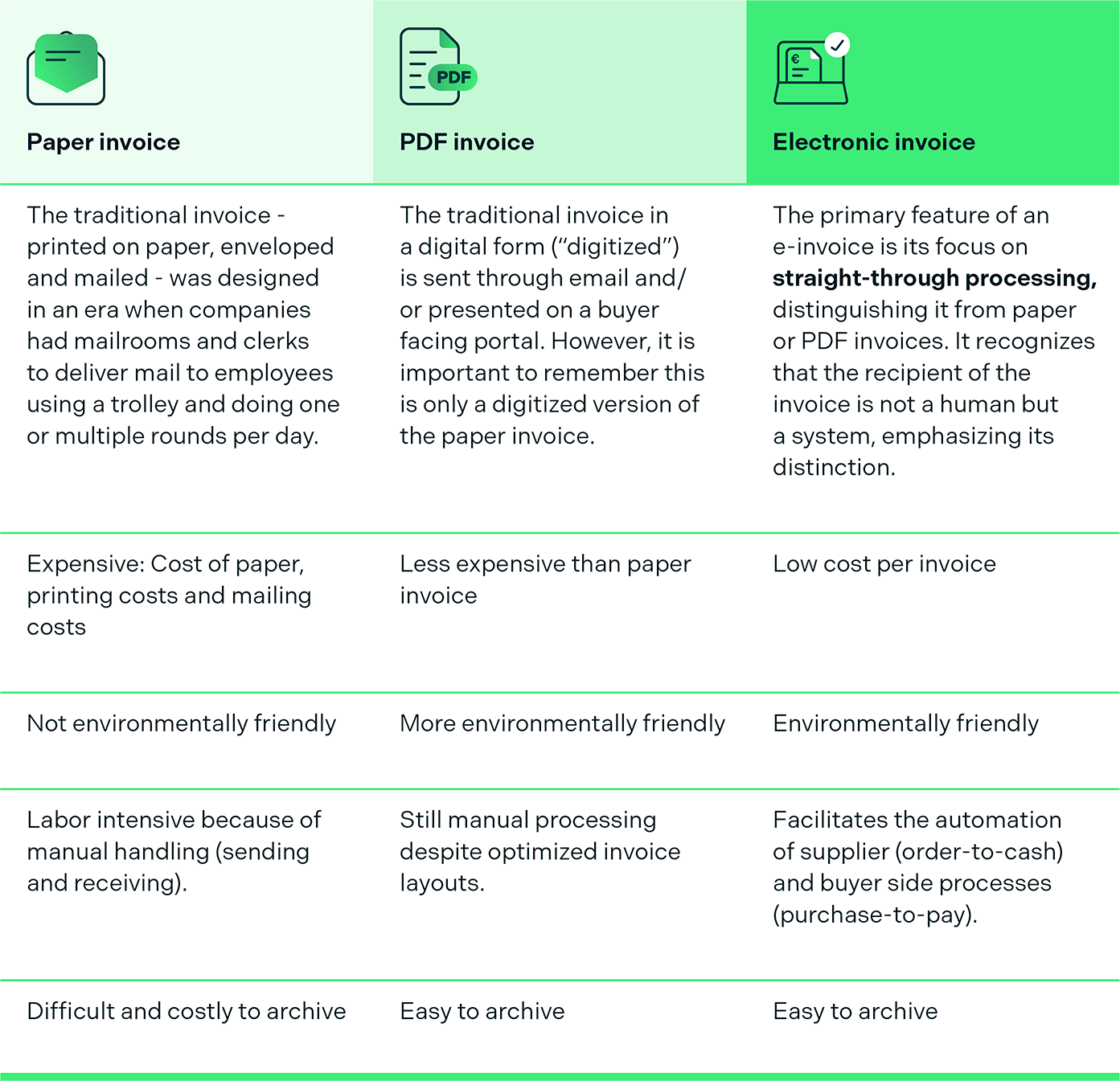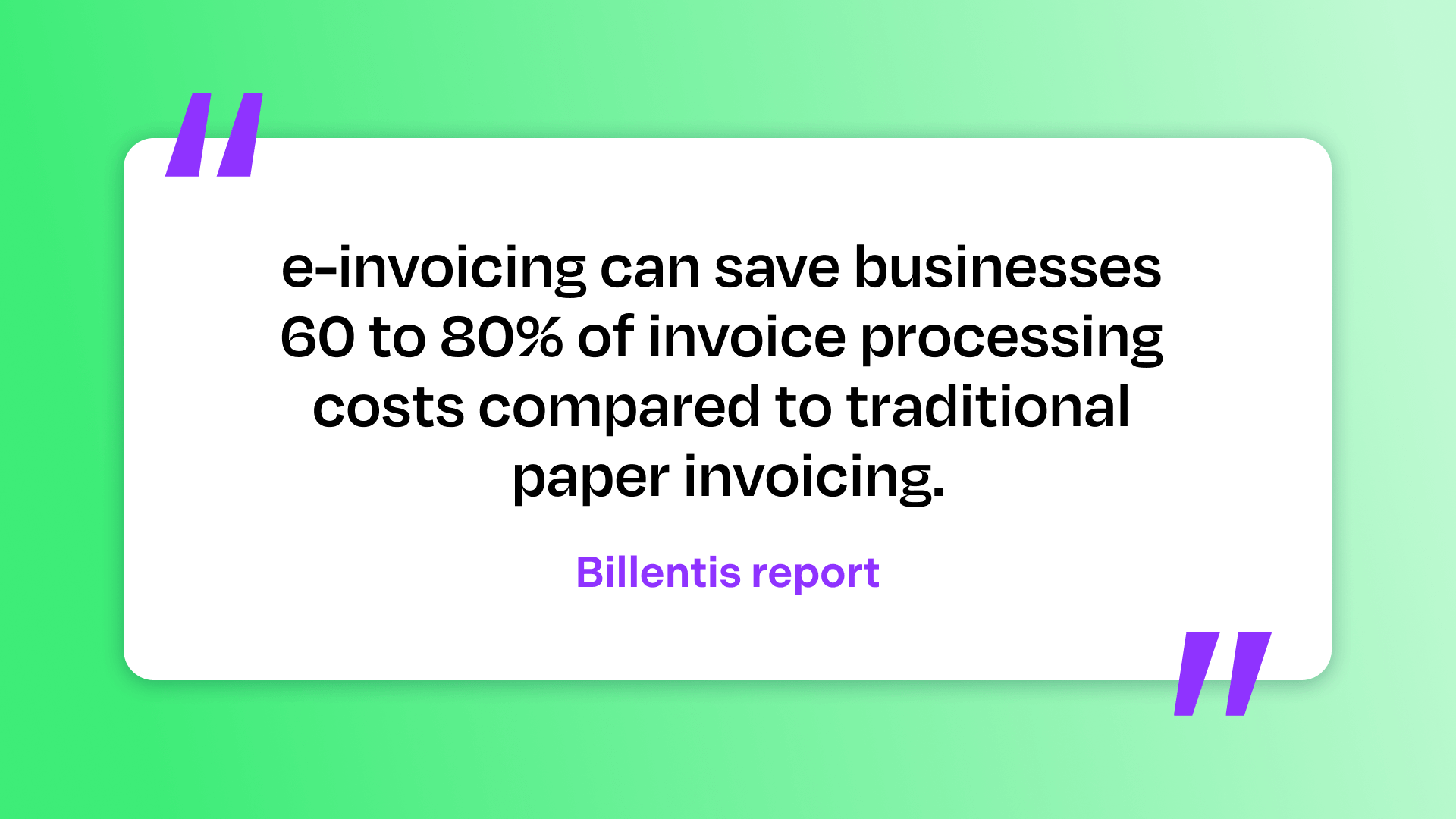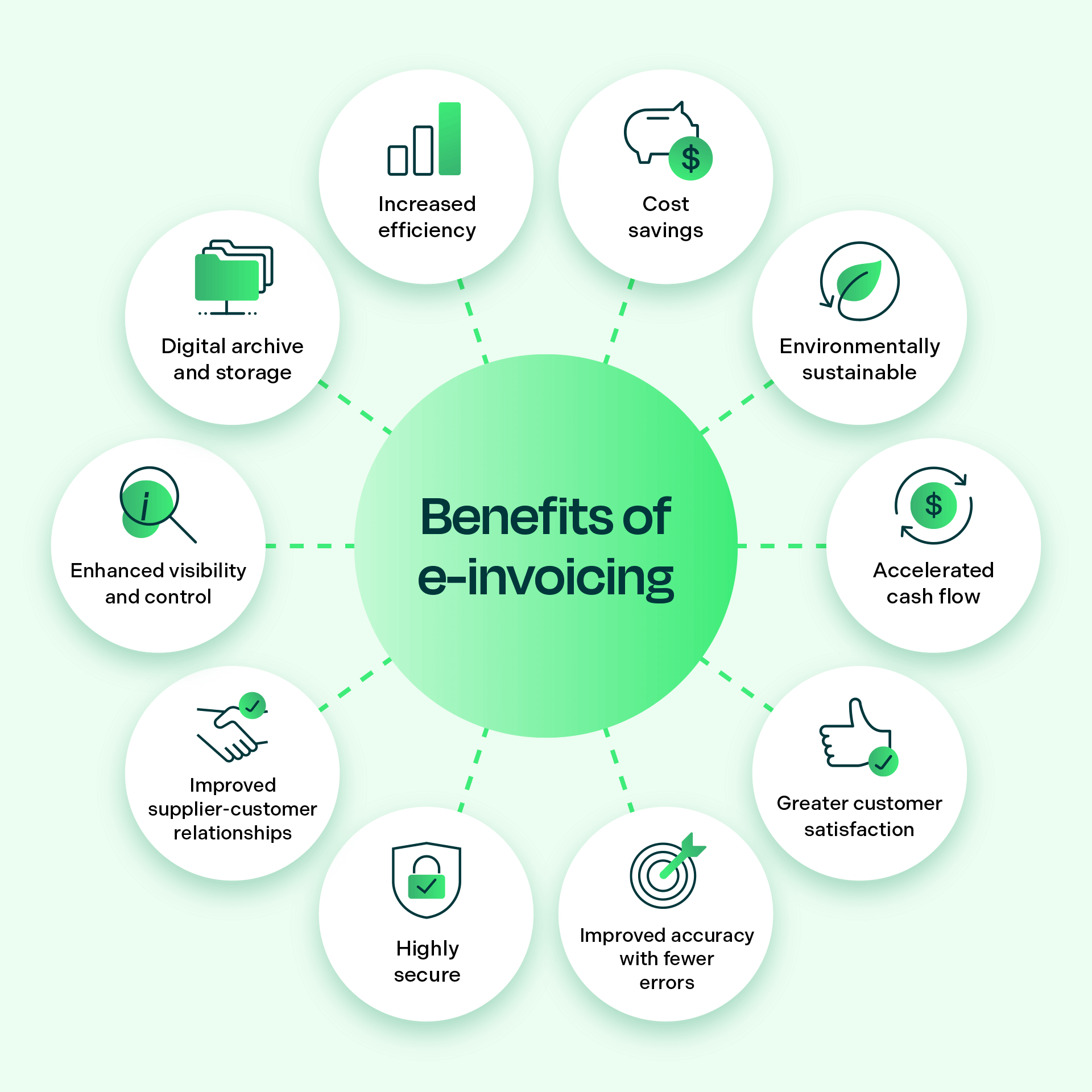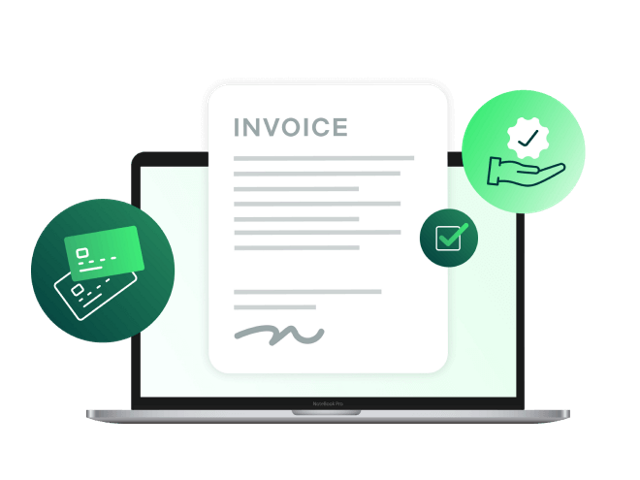Looking to improve your bottom line and streamline your financial processes? Consider e-invoicing, the secure, efficient, and cost-effective way to send and receive invoices electronically.
E-invoicing is becoming increasingly popular for B2B and B2G transactions around the world. Research by management strategy and market research specialist IMARC Group predicts that the e-invoicing market will reach $35.9 billion by 2028, a growth rate of 20% over a five-year period (2023–28).
In Europe, lawmakers are mandating its use, and public sector entities need to be able to receive and process electronic invoices. Many countries are also on the verge of implementing national e-invoicing standards to facilitate B2B and cross-border e-invoicing, helped by the recent VAT in the Digital Age (ViDA) proposal by the EU.
In the United States, e-invoicing adoption has been slower due to a lack of regulatory requirements and standardized formats. However, the use of e-invoicing is increasing as more businesses recognize the benefits of electronic invoicing. Some U.S. states have also implemented e-invoicing requirements for public sector entities, and there are several e-invoicing standards available in the U.S. market.
As businesses become more aware of the benefits of e-invoicing, the adoption of this technology is gaining pace. In this blog post we’ll talk about the benefits of e-invoicing for your business.
What is e-invoicing?
But let’s first talk about what we really mean by e-invoicing. E-invoicing is a modern and paperless method of invoicing that utilizes digital technology to create, send, receive, and process invoices. Unlike traditional paper-based invoicing, where physical invoices are printed, mailed, and manually processed, e-invoicing automates the entire invoicing workflow.
E-invoicing is the electronic transmission of invoices in a predefined structured format. This format allows invoices to be automatically read by computer systems, which ensures instant delivery and receipt. As a result, the invoicing process is significantly accelerated. A paper invoice converted into a PDF format is not an e-invoice.

The benefits of e-invoicing
E-invoicing offers a wide range of benefits, but here are some of the most significant:
Increased efficiency
One of the main advantages of e-invoicing lies in its ability to significantly enhance the efficiency of the invoicing process. According to a report by Billentis, e-invoicing can save businesses 60 to 80% of invoice processing costs compared to traditional paper invoicing in most cases.
Introducing e-invoicing offers a transformative opportunity for your business to streamline billing operations. By automating the previously time-consuming manual tasks of invoice creation, delivery, and payment, e-invoicing revolutionizes your invoicing workflow and accelerates your financial processes.
And this transformation pays dividends. Because e-invoice formats come equipped with all the necessary fields, your employees no longer have to spend valuable time entering duplicate data into ERPs or accounting systems. Data is seamlessly exchanged between these finance systems and the accounts receivable (AR) solution.

E-invoicing simplifies the process of matching and invoices against purchasing or shipping documents, ensuring accurate reflection of ordered items by buyers. Moreover, as a supplier you can easily reconcile payments received against the original transactions, facilitating quicker and more efficient cash application.
Beyond the initial stages, businesses can receive timely and automatic reminders about any unpaid invoices. This can help businesses to improve their cash flow and reduce the risk of late payments. Additionally, e-invoices can be easily tracked and stored, which makes it easier to resolve disputes and manage exceptions.
Ultimately, an automated billing and invoicing process equips your businesses with heightened competitiveness. By streamlining financial operations, you can operate more efficiently, allocate resources strategically, and provide a superior customer experience. Embracing e-invoicing translates into improved financial agility and a stronger position in the market.
Improved accuracy and less errors
E-invoicing reduces manual errors such as ones that occur because of manual data entry One of the most heard excuses of customers is that they didn’t receive the invoice. It got lost in the mail, sent to the wrong person or never reached their email inbox. With e-invoicing there are no more lost invoices: your invoices are always sent to the right email address or portal.
Cost savings
Eliminating paper invoices and automating invoice processing can save your business a significant amount of money. This is because you no longer have to pay for the cost of paper, printing, envelopes, and postage. In fact, a recent study by Ardent Partners found that the average cost of processing a single invoice in the U.S. in 2023 is $10.18.
While there are some initial costs associated with implementing e-invoicing, these costs are typically offset by the long-term savings of automating processes and the elimination of the paper trail.
Enhanced security
E-invoices are transmitted through highly secure, encrypted emails or dedicated cloud services and channels, like Peppol, ensuring a significant reduction in the risk of unauthorized access or fraudulent activities.
This robust security infrastructure guarantees the protection and integrity of sensitive financial data throughout the invoicing process, providing you and your customers with peace of mind and confidence in the safety of their transactions.
From the buyer’s standpoint, e-invoicing significantly minimizes the risk of receiving fraudulent bills. Transmitting invoices through a secure network or portal offers enhanced security, as companies must be verified members of the network, identified through KYC-procedures (Know Your Customer). For instance, AP portals maintain a comprehensive list of trusted, verified, and approved suppliers, ensuring a trustworthy invoicing process for all parties involved.

Additional benefits
Overall, e-invoicing can offer a number of benefits for your business, including cost savings, increased efficiency, improved accuracy, improved security, and compliance.
But there are some additional less-known benefits of e-invoicing:
Improved cash flow
The payment period typically starts at the receipt of the invoice. With e-invoicing, invoices are immediately sent, which greatly accelerates the payment process and shortens payment cycles. This can lead to improved cash flow for your business.
You can even get paid faster by incorporating more touchless straight-through processing through digital payments. This means that your customers can pay their invoices electronically, without having to print, scan, or mail them.
Greater customer satisfaction
A streamlined invoicing process, with instant delivery and receipt of e-invoices, coupled with flexible payment options, serves as a powerful incentive for customers to stay happy and maintain their loyalty.
Also, any issues arising from manual processes no longer put a strain on your customer support team. Because e-invoices are more accurate and easier to track than paper invoices, support teams can resolve disputes more quickly and efficiently and deal with more critical issues.
As businesses increasingly prioritize customer experience, personalization emerges as a rapidly growing trend. By crafting well-designed invoices and accompanying emails, you can achieve brand recognition and provide customers with exceptional initial and ongoing experiences.
These personalized touches serve as a testament to your business’s organizational prowess and effective management, leaving a positive impression on customers.
Enhanced visibility and control
By choosing e-invoicing, you gain improved visibility into your invoicing process and, more broadly, your overall financial operations. There are clear records of when invoices were sent, received, and sometimes even viewed by the recipients. This level of transparency ensures you always know the status of payments, enabling better cash flow management.
Additionally, the data collected through e-invoicing can be utilized for enhanced reporting and gaining valuable insights, empowering you to make informed financial decisions and optimize their processes further.
Digital archive and storage
E-invoicing also offers a systematic approach to archiving and storage. Many European countries already require or will soon mandate cloud-based archiving of invoices for specific periods, varying in length. This ensures that invoices are readily searchable and retrievable, particularly during audits or compliance checks.
Unlike paper invoices vulnerable to water or fire damage, e-invoicing provides a more secure and reliable storage solution, especially in challenging environments. The digital nature of e-invoices safeguards critical financial records, providing businesses with peace of mind and enhanced data integrity.
Saying goodbye to paper: environmental sustainability
Embracing e-invoicing is a powerful way for businesses to reduce their environmental impact. According to the aforementioned report from Billentis, businesses globally send around 550 billion invoices each year. That’s a lot of paper and waste. E-invoicing actively curtails paper usage, which directly benefits tree conservation efforts and lessens waste in landfills.
E-invoicing also exerts a positive influence on greenhouse gas emissions. Unlike traditional invoicing methods involving printing, packaging, and transportation, e-invoicing eliminates the need for physical movement. As a result, fewer vehicles on the road translate to reduced fuel consumption and, consequently, a decline in emissions.
In the pursuit of sustainability, some buyers are requesting that suppliers only deliver electronic invoices. They help businesses improve their ESG ratings, which are a measure of their environmental, social, and governance performance.
Making the switch to e-invoicing is a simple way for businesses to show their commitment to environmental responsibility and sustainability. It’s a powerful step toward ensuring a more sustainable planet for generations to come.
| E-invoicing sustainability benefits | Outcomes | |
| 1 | Reducing paper usage | Less printing, less energy consumption, less trees lost, less waste in landfills |
| 2 | Fossil fuel reduction | No greenhouse gas emissions because of mail delivery via postal services |
| 3 | Less usage of ink | No more harmful ink, ink cartridges and other chemicals polluting the environment |
| 4 | No need for physical storage | Storage space is limited to servers in datacenters |
Improved supplier-customer relationships
In a way implementing e-invoicing is all about strengthening the relationship between you and your buyers, and providing great customer service. By sending invoices electronically, you can free up your team’s time to focus on manual exceptions and reconciliation of invoices or checking purchase orders.
E-invoices are also more efficient for buyers. They can be processed in seconds, and all of the data fields are available. This means that buyers can use automation to capture what they need to get the invoice paid, and in theory 100% of the invoice data can be captured.
Finally, e-invoicing can foster better communication between businesses. Automated payment reminders and status updates can help to keep everyone informed of the status of an invoice.
Legal compliance and data integrity
E-invoicing systems often need to comply with legal requirements and tax regulations. Tax requirements vary from country to country but there is a real trend for e-invoicing to be mandatory so any VAT gaps that occur – in the old world – will be addressed by e-invoicing.
An essential element is data integrity as it ensures that invoices remain tamper-proof and legally valid. There are a number of ways to ensure compliance:
- Standardized formats: Many countries have adopted standardized e-invoicing formats, such as the European Union’s EN 16931 standard. These formats ensure that invoices are formatted correctly and contain all of the required information.
- Digital signatures: Digital signatures can be used to verify the authenticity of e-invoices. This helps to prevent fraud and ensure that invoices have not been tampered with.
- Encryption: Encryption can be used to protect the confidentiality and data of e-invoices. This helps to ensure that only the intended recipient can view the invoice.
- Audit trails: E-invoicing systems typically maintain audit trails that track the creation, transmission, and receipt of invoices. This helps to ensure that invoices can be traced back and data in e-invoices can be verified if there are any problems.
- Using a secure network: E-invoices should be transmitted over a secure network, such as HTTPS, to prevent unauthorized access.
Preparing for the change
It’s only a matter of time before e-invoicing is mandatory all over the world. If you are looking for a way to improve your business’s financial processes, e-invoicing is a great option to consider.
It offers a number of benefits, including cost savings, increased efficiency, improved accuracy, improved security, and compliance. E-invoicing can also help your business improve cash flow, customer satisfaction, visibility and control, and environmental sustainability.
If you are interested in learning more about e-invoicing, or want to prepare for e-invoicing mandates, get in touch with us.









